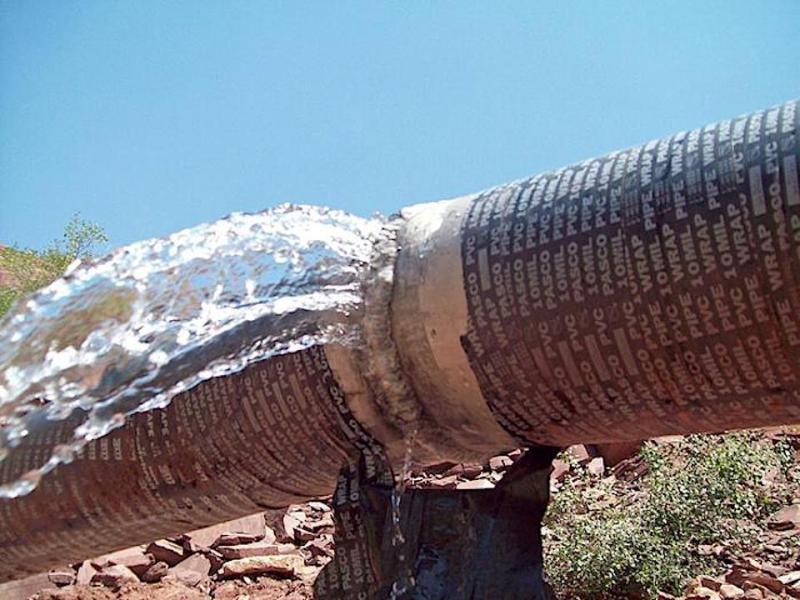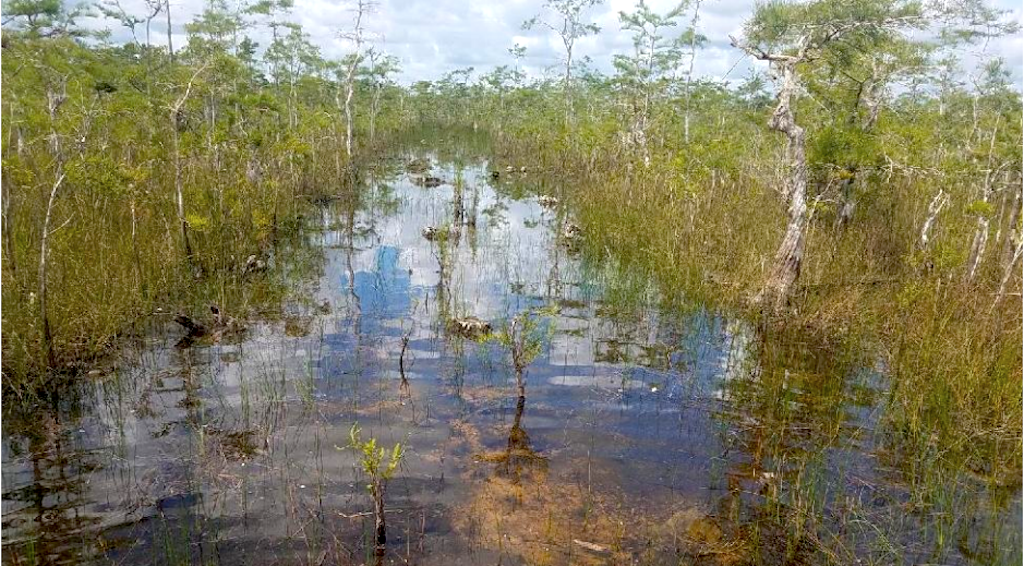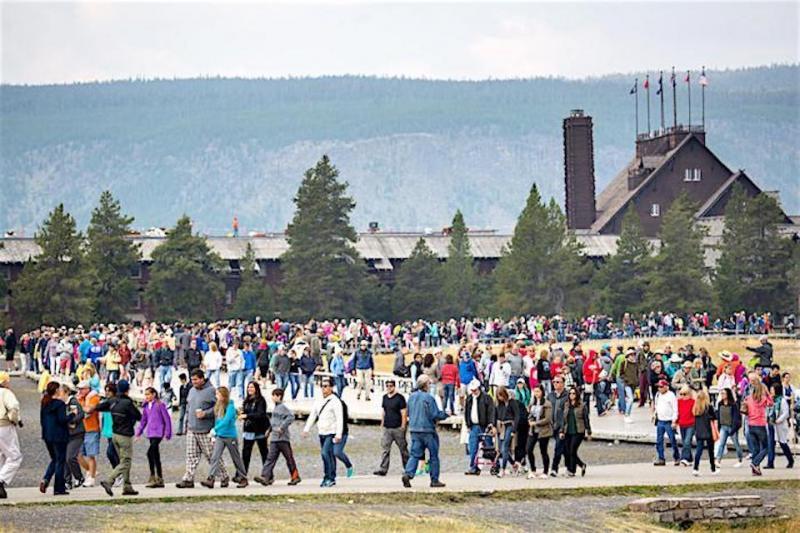
The partial government shutdown brought vandalism to Joshua Tree National Park in January/NPS
The past year brought many newsmaking events to the National Park System and, unfortunately, not all were positive. It started, of course, with the partial government shutdown that created more than a few problems for the park system, the lack of a Senate-confirmed director of the National Park Service continued throughout the year, hurricanes inflicted damage on coastal parks, and construction of a border wall in Organ Pipe Cactus National Monument very possibly destroyed some archaeological sites there.
But there was positive news, too. Acadia National Park in Maine got the go-ahead to implement its traffic management plan to relieve vehicular congestion, the years-long effort to restore the Jenny Lake area of Grand Teton National Park in Wyoming was completed, final approval came for Yellowstone National Park staff to transfer excess bison to the Fort Peck Indian Reservation, Finland agreed to return some artifacts taken from Mesa Verde in the late 1800s, and the restoration of the Paradise Inn Annex at Mount Rainier National Park in Washington was celebrated.
To look back over the past year in the National Park System, I sat down with Theresa Pierno, president and CEO of the National Parks Conservation Association, to discuss the news-making events.
Partial Government Shutdown
Certainly, the top story of the year in the park system was the Trump administration's decision to keep the parks open -- with skeleton staffing -- while the president and Congress faced off over the federal budget. There was vandalism in some parks -- at least one Joshua tree was cut down in its namesake park, SUV drivers detoured around road barriers at Big Bend National Park to explore closed areas, garbage overflowed in Sequoia National Park and elsewhere -- and the Interior Department responded by giving the Park Service permission to use funds collected via the Federal Lands Recreation Enhancement Act that were intended to be segregated specifically to address the maintenance backlog and to enhance, not maintain, the visitor experience.
"It's the longest partial shutdown in U.S. history, and of course we had Interior Secretary David Bernhardt basically abandon the obligation of really protecting the national parks by keeping parks open with only skeleton crews," said Theresa Pierno, president and CEO of the National Parks Conservation Association. "And then ultimately draining the park fee money accounts to try to keep those gates open. And of course, we saw some really significant damage in places like Joshua Tree, where Joshua trees were actually cut down, additional roads were created. And just facilities that couldn't handle it."
In the wake of the tapping of the FLREA accounts, NPCA filed a complaint with the Government Accountability Office arguing that Interior was breaking the law by doing so.
"Of course, even as volunteers tried to help, and Park Service staff, the morale was just unbelievable, just to see the parks they love so much and protect, so damaged and neglected," said Pierno.
Part of the problem with taking funds from FLREA to bring maintenance staff back into the parks during the partial shutdown, she said, was park maintenance projects were delayed and it impeded "park managers from managing the parks properly.
Funding The National Park Service
Congress late in December approved a Fiscal 2021 budget that included a 3 percent increase for Park Service operations, a trivial increase when measured against the roughly $12 billion maintenance backlog across the National Park System.
"No, they can't," Piero replied when asked if the Park Service can get by with such small annual increases. "When you look at the increase of visitation that they've seen, 14 percent increase in visitiation during the same period where they've had a 14 percent reduction in staff. Visitors are going to continue to notice not only facilities and the maintenance challenge, but also fewer park rangers. So you don't have the kind of experience that you once had in a park, which is so critical for families and especially young campers and people that are just experiencing parks in their youth. Those are things that they're not going to be able to get back.
"When you look at the overall situation the parks are in ... and we're doing better in some cases than other agencies, but the reality is, with the increase in popularity, visitation and needs and the continual decline of the operations funding, it's just a perfect storm, really, she added.
Earlier in 2019 professors from Harvard and Colorado State University proposed a range of strategies they believe would quickly enhance the Park Service’s fiscal fitness if adopted by Congress. Professor Linda Bilmes, the Daniel Patrick Moynihan Senior Lecturer in Public Policy at the Harvard Kennedy School, and John B. Loomis of Colorado State, suggested that:
- Congress provide the Park Service with a two-year appropriation, a move that would help see that the agency doesn’t “get caught up in the constant stopgap shutdown crises, which are a feature of our current budget process,” said Bilmes.
- Create an endowment for the agency.
“The mission of the National Park Service is a perpetuity mission. They are supposed to be protecting these places to be pristine forever,” she said. “That’s a pretty complicated mission, and the way that most organizations that have a perpetuity mission are funded is that they have an endowment, which is a perpetuity type of funding mechanism.”
- Give the Park Service bonding authority to address infrastructure repairs and needs.
- Put a check off box on tax returns that would allow taxpayers to contribute an extra amount specifically for the Park Service.
- Restructure the way concession fees and park entrance fees are collected and spent.
The two professors hope their research will catch the eye of Congress and that they’ll be given an opportunity to appear before the House Natural Resources Committee and the Senate Energy and Natural Resources Committee to explain in detail their proposed strategies.

Frequent breaks in the Transcanyon Pipeline at Grand Canyon National Park have park officials needing roughly $100 million to replace the antiquated pipeline/NPS file
That $12 Billion Maintenance Backlog
In recent years there have been annual efforts in Congress to pass legislation specifically to provide an extra appropriation for the Park Service to use in reducing its maintenance backlog. However, so far it has failed to accomplish that. Whether the current Congress can approve and send to the president the Restore Our Parks Act, which would provide about $6.5 billion over five years specifically to be spent on backlogged maintenance before the end of 2020, remains to be seen.
"This is one of the few places where we really see bipartisan support," said Pierno. "Just in the House there were about 330 co-sponsors, as well in the Senate 47 co-sponsors, so you have this incredible support by about 70 percent of Congress, and you have tremendous support from the average American, and the administration says they're also supportive. But yet we can't get it to the floor (of Congress) yet, so we really need encouragement from the public and push to get this Restore Our Parks Act voted and passed, because it will have a huge impact."
Climate Change Impacts
Impacts related to the changng climate continued to impact the National Park System, and perhaps were most visible along the Eastern Seaboard where potent storms battered shorelines and washed over barrier islands. Cape Lookout National Seashore on the Outer Banks of North Carolina was particularly hard-hit in September by Hurricane Dorian, which although just a Category 1 storm, or the weakest on the scale of hurricane strength, cut 54 breaches in the seashore's barrier island. Neighboring Cape Hatteras National Seashore also was pummeled by the storm.
In Alaska, national park units struggled with melting permafrost and a lack of snow and cold at times, and drought continued to impact parks in the Southwest.
"As bad as the funding picture is, there really is no bigger threat to the future of the national parks than climate change," Pierno said. "It's already destroying so many of our treasures, our natural history and culture. When you look at sea level rise and you look at ten percent of the shoreline is in the National Park System of the United States, and you look at the number of marine parks that are threatened, places like Cape Hatteras with the erosion that is taking place, the wildfires in the greater West, it's just incredible. And just recently we supported introduction of legislation called the American Public Lands and Waters Climate Solution Act of 2019, from the House Natural Resource Committee, which is looking at things like science-based guidance for land managers to use, putting emission targets as a priority above leasing, and really kind of updating the leasing cost so that the industry is really paying their fair share when they look at developing fossil fuels on public lands. We are all owners of those lands."

Energy exploration at Big Cypress National Preserve in Florida is impacting the landscape/Quest Ecology
Energy Exploration in the Parks
Big Cypress National Preserve in Florida continued to be ground zero for energy exploration in the National Park System due to the fact that its mineral resources are privately owned. As a result, an oil exploration company, Burnett Oil Co., sent 33-ton vibroseis trucks out across the preserve to literally shake the ground with hopes of finding recoverable oil reserves. So far there's been no public announcement of what this year's searching produced, but the company has not yet sought Park Service approval to begin activing drilling.
Across the country in North Dakota, state regulators have been approving permits for an oil refinery to be built fewer than five miles from the south entrance of Theodore Roosevelt National Park.
"You're looking now at more than 19 million acres of public land that has been offered for oil and gas leasing, just since this administration took office," the NPCA leader said. "That is just staggering. And while they're doing this, they've really made it much more difficult for the public and really key stakeholders to have a voice in the decisions, and they eliminated different vital kind of environmental protections. Without really immediate action, parks are going to suffer for a long time from these kinds of leases that are being put in place now. More than about 45 of over 100 actions that the administration has done, threatening the park and public lands, it's basically benefitting the extractive industries, oil and gas development in particular.
"And we went through a process with the Obama administration, where we looked at master leasing plans, where we were able to come up with (lists of) these places that are off-limits, and these are areas for leasing oil and gas and other extraction industries," she added. "And there was agreement, and there was a plan put in place, and the very first thing that they (the Trump administration) did was kind of throw that out and open it up, and now they're going after places that have impacts, whether it's Grand Teton or Big Cypress or Theodore Roosevelt, and places that we never saw impacts. Right up to the borders of a national park, and even within the national parks for leasing. So it's just completely turned, and it's a very extreme situation we're facing now."
Invasive Species
If there's a "silent killer" in the National Park System, it literally could be invasive species. As Traveler reported earlier this month, non-native animal species are an ecosystem-upsetting menagerie that poses a significant threat to both native species and the very integrity of the parks.
It is an invasion on land and in the water, one that is attacking wildlife that has evolved with the landscapes. For some parks, the problem has gone beyond being an isolated problem and turned into a malevolent force that is literally impairing the very nature of the parks and some of the reasons they were set aside in the first place.
At Everglades National Park, non-native Burmese pythons and native alligators face off in eat-or-be-eaten battles. Northern snakehead fish are poised to upend the watery ecology of parks such as Prince William Forest Park and the Chesapeake and Ohio Canal National Historical Park, while lionfish threaten the marine environments of Everglades, Dry Tortugas, Virgin Islands, and Biscayne national parks. Come ashore and you might encounter feral hogs that rototill vegetation in Great Smoky Mountains National Park as well as Big Thicket National Preserve and even pose threats to human visitors.

Burmese pythons in Everglades National Pare are just one of hundreds of invaders across the National Park System/NPS
That small handful of invaders is part of a much larger attack on native species in the parks and their surrounding landscapes, as more than 300 invasive animal species today can be found in the park system.
"It's a huge problem, and it's also in many cases connected with climate change. The issue with the Everglades and the python not so much, but certainly many other issues related to some of the invasives and the impacts that are happening and the diseases that are hitting the forests and some of the impacts related to the wooly adelgid and the ancient hemlock tree populations," said Pierno. "And then you have things like feral pigs in the Smokies, a whole host of issues that are happening in the Great Lakes as well, their ecosystems are seeing tremendous invasives. Asian carp and impacts related to different water species.
"... It's a huge issue, and we're threatened in so many areas, but this is an area that definitely needs more attention, more resources. In many cases they have ways in which they can address it, but it takes additional dollars, and they don't have the resources to be able to do it," she said.
Political Impacts
National parks are not immune from politics. That's been evident in the reality that there has been no Senate-confirmed director of the National Park Service and in the number of '"acting" positions across the agency, as well as in Secretary Bernhardt's decision to order, without going through the normal rule-making process, national parks to allow e-Bikes onto trails where muscle-powered bikes are allowed.
While David Vela, the deputy director of the Park Service given the authority of the director, is a long-tenured, seasoned agency manager, the fact that he hasn't been confirmed drags on the agency, said Pierno.
"We've had this continual rotation of acting directors, so you don't have the kind of stability (of a confirmed director)," she said. "If you think of somebody who's been confirmed by the Senate and has gone through the process, their ability to work with Congress, on both sides of the aisle, and to be able to help to be really that strong voice advocating for the Park Service needs, that gets lost. And so, basically, they put people in positions to ultimately act as rubber stamps for whatever policy decisions the leadership wants to make. That's where we are right now.
"That's a dangerous place to be," continued Pierno. "We've seen past directors at times really push back and challenge and have to speak out, that's just not the position that an acting director (takes), because they easily can just replace them with another acting director."

Crowds are an ongoing problem for some national parks, including Yellowstone/NPS
Overcrowding In The Parks
While Acadia National Park was able to move forward with its traffic management plan, overcrowding issues continue to confront parks such as Zion, Arches, Yosemite, Grand Canyon on its South Rim, Rocky Mountain at times, Glacier, which is working on a Going-to-the-Sun Road management plan, and elsewhere. While it seemed as if Arches was going to follow in Acadia's footsteps and move towards a reservation system of sorts to manage traffic flows into the park, Interior Department officials told the park to go back to the drawing board. Zion for a number of years has been working on a management plan with no end in sight.
"Restore Our Parks Act would be one major step forward and get serious about making smart and substantial investments in our parks and resources so that visitors can keep coming for generations," said Pierno. "There are several things we can do as well. Highlighting those parks that are not as popular but are just as fabulous. I think Utah did such a great job with their (Mighty Five) campaign and highlighting their parks. Almost to the point where they've marketed those so strongly where there are so many other parks that haven't been marketed but yet are actually incredible finds. I think that that would certainly be one way, educating the public more and really having a campaign that does that.
"But also, every park is really unique, so what will work for Acadia might not work for Arches, and so parks really have to have the opportunity to develop their own plans on a case-by-case situation," she said. "And they need the support of leadership. Once they develop really good plans, they need to be able to test them out and move forward. Otherwise, visitors will be disappointed going to these places and then being locked out or experiencing huge waits to get into the national parks, which they're experiencing in some of the national parks today."
Organ Pipe Cactus National Monument's Border Wall
Construction of a border wall in Organ Pipe Cactus National Monument in an effort to control undocumented immigration from Mexico and Central America is feared to have destroyed archaeological sites in the monument and there are concerns it also will adversely impact species that migrate, such as the endangered Sonoran pronghorn (See Wednesday's story on this incredible species and efforts to bolster its population.)
"The damage is just unbelievable, and of course now with the approving of Fiscal Year 2020 spending bills, it allows for destruction of the monument and continuing bulldozers to go through and basically plow down the iconic saguaro cactic and impact the fragile wildlife," Pierno said. "We knew this kind of damage was possible, but now witnessing it?! It's just unbelievable. Many people, they say, 'Well, you know, what's the big deal?' But if you think about the wildlife species that are going to be impacted. Organ Pipe is a place with bobcats and coyotes and desert tortoises and mountain lions and on and on, and they roam freely in this landscape. They need to. They need to be able to search for food and water and mates.
"The disruption of a wall can take an endangered species to the very brink and totally destroy this park and its wildlife forever. And so, to continue with really what's unnecessary, new walls, when there's so many other options for meeting their needs and what they want to do, it just seems outrageous. It's really an attack on our national parks, and so we continue to see this really national treasure destroyed," said the NPCA president.
Many other parks made the news in 2019, both in favorable, and not so favorable, light:
* A fossil trackway not quite 300 million years old came to light at Grand Canyon National Park;
* Progress continued to be made to restore healthy fisher populations in national parks in Washington state;
* Researchers discovered an important gathering point for piping plovers at Cape Hatteras National Seashore;
* The landscape at Santa Monica Mountains National Recreation Area slowly was recovering from the 2018 Woolsey Fire;
* A researcher looked into the dark past of segregation in national parks in Virginia;
* Progress continued to be made on tamping down the population of non-native lake trout in Yellowstone Lake in Yellowstone National Park.
For look at other news and features from around the park system in 2019, browse through Traveler's pages.



Comments
The vandalism at Joshua Tree has been ongoing, and there's no evidence that the gov't shutdown CAUSED more or less of it. STOP the drama.
"Energy Exploration in the Parks "
None of the examples provided were of energy exploration IN the parks. Just STOP!
Fred, an oil exploration company, Burnett Oil Co., sent 33-ton vibroseis trucks out across Big Cypress National Preserve to literally shake the ground with hopes of finding recoverable oil reserves.
Mr. Repanshek, please, please, do not stop or even consider letting up in any way under any conceivable circumstances. If anything, you are not reporting enough or in strong enough terms to accurately reflect just how bad the current "wretched hive of scum and villainy" as some members of the press are now calling it has been for America. The situation truly is "dramatic" and the "drama" that we are living through needs to be reported, despite protests from the hive.
It is disingenuous, to say the least, to try to mislead the public by claiming that the shutdown had no effect on the atrocities committed by rightwing vandals at Johua Tree, equally disingenuous to try to claim they weren't rightwing vandals given the signs they left behind urging their cohorts to "destroy" all public lands while law enforcement and oversight in the parks was understaffed due to that same shutdown.
As far as examples of energy exploration in the parks go, Big Cypress National Preserve is a National Park Service property, a designated unit of the National Park System. When you have private oil and gas exploration company trucks rolling across and pounding Big Cypress National Preserve in the "hopes of finding recoverable oil reserves" under it then you truly do have energy exploration in the parks and no loose relationship with the truth can change that fact!
The hive will stop at nothing in their selfishly destructive quest and you must not stop defying them. When they attack you, stand firm and continue to let them know they shall not pass!
Rumple, you're right that we're not reporting enough.
That's why we need everyone who reads the Traveler and views the parks as their favorite destinations need to support our 501 (c)(3) nonprofit operation. As you likely know, there's just one set of hands at this keyboard week in and week out, and if everyone who read the Traveler throughout the year gave just 50 cents a year we'd have a robust news organization.
Traveler is the only news organization dedicated to covering national parks and protected areas year in and year out. If you want to see our coverage grow and become not only more robust but reaching into all corners of the park system, please make a donation. A recurring monthly donation would be appreciated even more greatly.
I agree with you and Rumple, Kurt. I've been largely silent due to health issues, but hope to contribute to the efforts.
Much appreciated, Rick. Heal quickly!